Particle Size Reduction For Animal Feeds: Part 4
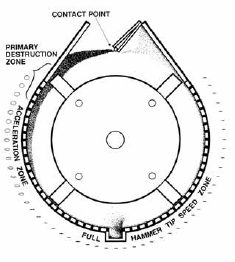
Basic Operational Concepts
Particle size reduction in a hammermill occurs as a result of the impact between a rapidly moving hammer and a relatively slow moving particle. The particle breaks and is accelerated towards the screen. Depending on the particle size and angle of approach, it either passes through the screen or rebounds from the screen into the rapidly moving hammers again. As materials move through the grinding chamber they tend to approach hammer tip speed. Since reduction only occurs when a significant energy is transferred from the hammer to the particle (large difference in velocities), less grinding takes place when the particles approach hammer tip speed. Many manufacturers incorporate devices within their mills to interrupt this product flow, allowing impact and reduction to continue. Tear circle hammermills have a more positive, natural redirection of product at the inlet than "full circle" design machines.
While the basic operational concepts are the same for all hammermills, the actual unit operating conditions change rather dramatically depending on the materials being processed. Grains such as corn, wheat, and sorghum and various soft stocks like soybean meal tend to be friable and easy to grind. Fibrous, oily, or high moisture products like screenings, animal proteins, and grains like oats and barley on the other hand, are very tough and require much more energy to reduce. Consequently, the hammermill set up that works well for one will not necessarily work well for the other. The following discussion covers such factors as tip speeds, hammer patterns and position, horsepower ratios (to hammer and screen area), and air assist systems.
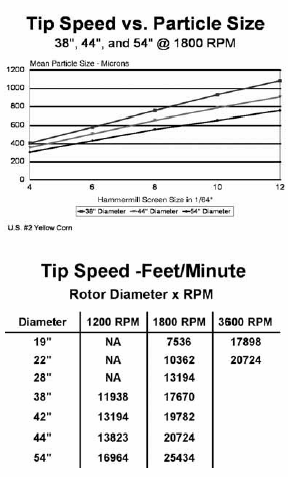
Tip Speed
Tip speed, in addition to screen size has a significant influence on finished particle sizing. High tip speeds (>18,000 Ft/Min) will always grind finer and produce more fines than lower tip speeds. Low tip speeds (<13,000 Ft/Min), on the other hand, produce a coarser granulation with fewer fines. As a rule smaller screen hole sizes should be used with higher tip speeds, and larger screen hole sizes with lower tip speeds. Tip speed is simply a factor of mill diameter and motor RPM and is not easily changed on direct coupled machines. There are a few V-belt drive hammermills on the market today.
Tip Speed -Friable Products
For producing a uniform granulation with few fines
on friable products like corn, wheat, grain sorghum,
pelleted ingredients, and solvent extracted meals
an intermediate tip speed is normally desirable.
Hammermills with a tip speed of 13,000-18,000
Ft/Min will produce a high quality finished product
with excellent capacity and efficiency. 38" diameter
mills with 1800 RPM motors (17,800 Ft/Min) and
44" mills with 1200 or 1500 RPM motors (13,500
or 17,250 Ft/Min) are both used extensively in
the processing of all kinds of feed ingredients.
Tip Speed - Fine Grinding And Tough To Grind Materials
For fine grinding friable products and tough to grind materials like soybean hulls, mill feed, and mixtures
with animal protein products, a higher tip speed is indicated. Because more energy is required to
grind these kinds of materials a higher tip speed is beneficial. Normal tip speeds for fine grinding and
fibrous materials are obtained on 42" and 44" mills operating at 1800 RPM (19,500 and 20,000
Ft/Min), or 28" mills operating at 3000 RPM and 54" mills operating at 1500 RPM (21,000 Ft/Min).
Recent developments in hammermill grinding have included the use of 54" diameter mills operating
at 1800 RPM. This very high tip speed (>25,000 Ft/Min) is particularly well suited to fine grinding at
high capacities and high efficiency. Because a larger screen (hole) sizes can be used while maintaining
the fineness of the grind, operating costs are reduced as well.
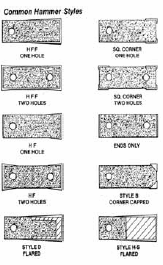
Hammers
There is an unlimited number of hammer styles available from many suppliers around the world. At the same time, there are distinctly different types of hammers used in different regions of the world. European feed processors tend to favor a plain two-holed hammer, with no hardfacing or edge treatment. North and South American feed millers tend to favor a hammer with a flared hardface end (or ends). Each market tends to find a hammer type that best suits their particular needs.
Hammer patterns and positions have a profound effect on the performance of any hammermill. Because different materials grind differently, the ideal number of hammers and clearance to the screen will need to be adjusted according to each application. At the same time, it is important to make sure the hammer pattern covers the working screen, without having hammers in line.
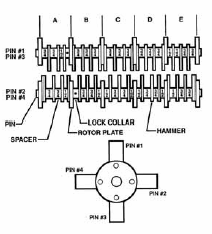
In most cases, the hammer pattern should include double hammers on the outside rolls of at least two opposing pins. Because the material in the grinding chamber near the sides of the mill moves more slowly (dragging on the sides), the outside rows of hammers must do more work and are subject to more wear. Some manufacturers use thicker or longer hammers on the outside rows.
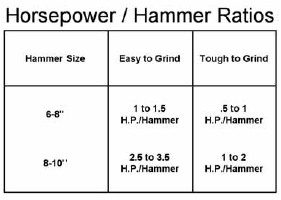
There is also a relationship between the HP/hammer and the wear on the hammer. Too much HP/hammer will tend to "rock" the hammer each time the hammer swings through a bed of material on the screen, leading to rapid wear of the hammer hole and hammer mounting pin. In extreme cases, the bed may be so deep that the hammer wears above the hardfacing. If this happens the correct solution is not to use a hammer with more hardfacing extending up the hammer, but to reduce the H.P., increase the number of hammers, or reduce the feed rate to the mill. Too little HP/hammer dramatically reduces hammermill efficiency by consuming motor horsepower simply to turn the rotor with its load of hammers. Too little HP/hammer also tends to wear the hammers right on the corner and does not effectively use all the working surface of the hammer.
Particle Size Reduction For Animal Feeds: Part 2 - Grinding Equipment, Roller Mill Grinding, The Roller Mill Grinder
Particle Size Reduction For Animal Feeds: Part 3 - Hammermill Processing, Equipment Description, Basic Machine Characteristics
Particle Size Reduction For Animal Feeds: Part 5 - Screens, Feeders, Air Assist
Particle Size Reduction For Animal Feeds: Part 6 - Other Considerations




